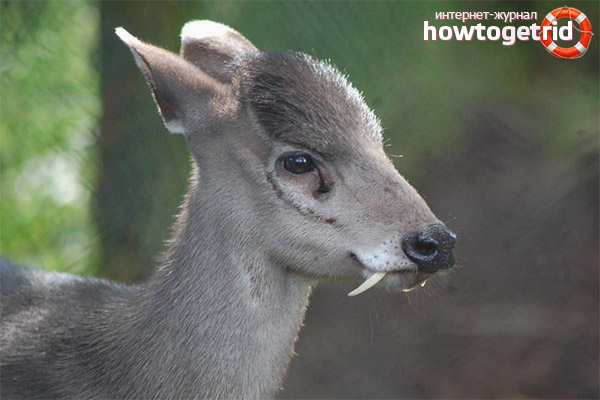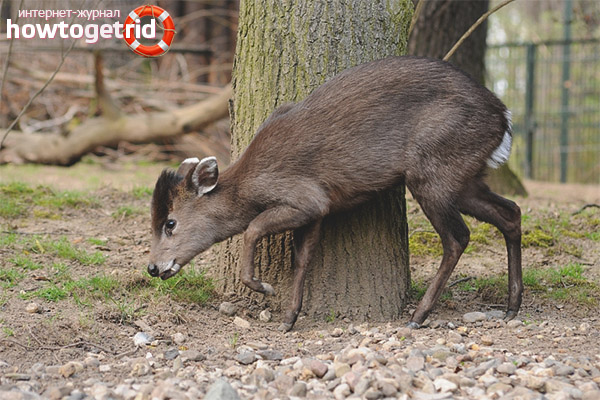The content of the article
Crested deer has not only an interesting name, but also no less interesting appearance. He got his name for a reason - rarely what animal can boast a thick tuft of hair on his forehead. However, the hairstyle is far from the only distinguishing feature of this animal. A detailed description of the appearance and lifestyle of the crested deer is given in this article.
What does a crested deer look like
This animal has a more modest size compared with other species of deer and ungulates. The length of their body, as a rule, slightly exceeds a meter, and the height at the withers ranges from 40 to 50 cm. With these parameters, the crested deer rarely weighs more than 40 kg. However, there were cases when larger individuals were found, whose weight was more than 50 kg, and growth at the withers reached 70 cm. This indicates the relationship of the body size of the animal with its habitat.
The color of crested deer wool has a variety of colors. The lower body is lighter than the back and legs, painted in gray or reddish color. The hair of the body is brown or dark gray. The tips of the deer’s ears, as well as the lips and the inside of the tail, are white. There are times when the eyes of an animal are surrounded by white lines. Among their species, crested deer are divided into 3 subspecies based on the color of the coat and habitat.
There is a difference between young and mature individuals - white spots located along the spine are characteristic only of young animals. Adult individuals cannot boast of such decoration.
The eyes of the deer are large and very dark, with a poorly distinguishable pupil. They are bordered by a series of long eyelashes, giving the animal a touching look. The crested deer's nose is black and always wet. On the edges of it are hard sensitive vibrissa hairs.
Such a famous crest begins its growth from the line of the eye and ends near the ears at a height of 17 cm, having a dark color. Small horns are hidden behind the mop of wool, which are difficult to see from the first. Therefore, male crested deer do not arrange fights using horns, as other types of deer do.
Habitat
The territory of crested deer is limited to southern and central China, as well as Burma and Laos. Outside of these areas this animal does not occur. There, the deer lives in forests at an altitude of up to 4,500 above sea level. They also like bushes overgrown with food and shelter from predators. Sometimes animals can leave their shelter and go to the settlements. At the same time, the crested deer is not afraid of people. According to various estimates, the population of these animals totals half a million individuals. It is not known whether there is a tendency to reduce their numbers.
Nutrition
Despite their frightening fangs, crested deer prefer exclusively herbaceous plants and cereals. In winter, they use fallen foliage of trees and young bark of shrubs as a feed. In spring, deer look for legumes, as they need to make up for the lack of protein after the cold season.
According to some unconfirmed reports, deer of this species can eat carrion if they have not eaten anything for a long time.However, their fangs are not suitable for tearing and chewing muscle fibers, which makes one doubt the veracity of this information.
Life among relatives and reproduction
In the afternoon, crested deer rarely show activity, trying to use this time to rest and digest food. They go in search of food at dusk, and by morning they prefer to arrange a rest. These animals have their own communication system. Deer use barking sounds to communicate. Also during courtship games they are able to produce whistling and clicks, using the nasopharynx and molars for this.
Despite their calm attitude towards human presence, in the wild, crested deer are very shy and do not enter into open confrontation, preferring to flee. When meeting with a predator, the animal escapes with its small light tail tailed up - this is a sign to the rest that danger is approaching.
There is no information about who exactly is the natural enemy of crested deer. Due to the secretive behavior of the animal, it is difficult to obtain information about it; therefore, the species has been little studied by zoologists.
Species protection
Despite the fact that the crested deer is fairly densely populated and has a relatively good number of individuals, this species is listed in the Red Book and is under protection. Scientists have found that species living in one particular territory have a greater risk of extinction than those living in different parts of the globe.
Currently, crested deer are successfully kept in European zoos. They have the ability to breed in captivity.











Submit